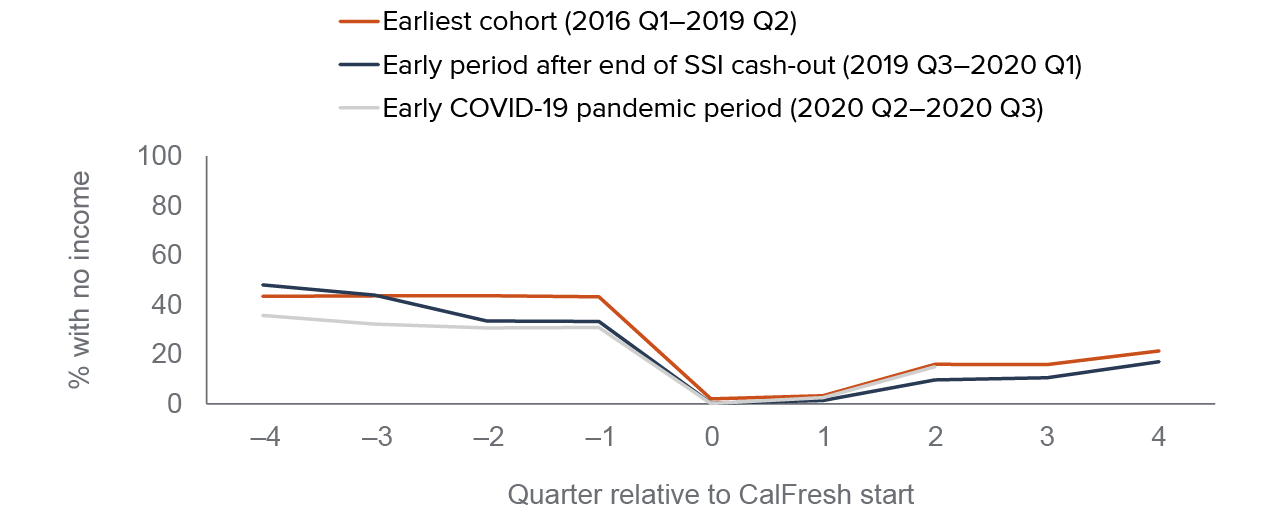Table of Contents
Key Takeaways
CalFresh, federally known as the Supplemental Nutrition Assistance program (SNAP), is one of California’s largest safety net programs. The program provides food assistance to 4.8 million Californians, and according to the most recent estimates, lifts about half a million Californians out of poverty. During the pandemic, federal and state policies have increased benefit levels and expanded eligibility for CalFresh. In this report, we go beyond annual poverty snapshots to investigate the double jeopardy of low and unstable income. To what extent do safety net resources stabilize incomes of CalFresh participants? And how did CalFresh and other safety net resources affect family budgets at the start of the COVID-19 pandemic? Our analysis finds:
- CalFresh and other safety net programs stabilize income for participants with current or recent employment. Benefits compensate for drops in earnings, reducing income drops by half.→
- Adults and their households newly enrolling in CalFresh in the early months of the COVID-19 pandemic were especially likely to benefit from its stabilizing role because most experienced a recent employment setback.→
- While about eight in ten adults who access CalFresh have some employment history, roughly half also have a period with no recorded income. Those without recent employment do not see the same stabilizing role of CalFresh benefits. Although outreach to those who have not yet connected to CalFresh brings additional challenges, finding ways to reach these adults, potentially through other programs such as Unemployment Insurance, could improve CalFresh’s stabilizing role.→
- In general, income instability is common among adults—and their households—accessing CalFresh. Nearly four in ten experienced both large negative and positive shocks (25% or more) to their incomes in the year and a half before CalFresh enrollment.→
- The income eligibility report that must be submitted every six months to maintain CalFresh eligibility creates income volatility for many who are apparently still eligible. The share of adults in our study with benefits from CalFresh drops by more than a third just after the six-month mark. Those without recent employment and single adults are more likely to lose benefits at that point. Further efforts to automate income reporting would help reduce this drop-off—and improve income stability.→
The Importance of CalFresh
The Supplemental Nutrition Assistance Program (SNAP), which provides food assistance to low-income individuals, is the United States’ most widely available social safety net program. While other safety net programs are designed to assist specific groups, SNAP is available to income-eligible citizens or permanent residents regardless of age, family composition, or participation in other safety net programs. About 4.8 million Californians—one in eight—participate each month in CalFresh; according to state estimates, about 6.5 million are eligible (California Department of Social Services 2022b). Roughly half of California’s young children participate in CalFresh by the time they turn six (Danielson, Thorman, and Bohn 2020).
In California, families are eligible for CalFresh (as SNAP is known in California) when their incomes fall under the federal poverty line ($27,750 in 2022 for a family of four). As of January 2022, the average monthly benefit per participant was $262 (Food and Nutrition Service 2022). CalFresh plays an important role during economic downturns; during the COVID-19 crisis, for example, increased benefits and a temporary postponement of required paperwork helped low-income families make ends meet.
While data from the California Poverty Measure indicate that CalFresh is roughly on par with the federal Earned Income Tax Credit in mitigating poverty (Bohn, Danielson, and Malagon 2021), we know little about how—in concert with other safety net programs—it moderates fluctuations in employment and incomes. While CalFresh can be used only for groceries, it frees up resources that low-income families can spend on other essentials, such as rent and utilities (Hoynes, McGranahan, and Schanzenbach 2015). Previous research at the national level using survey data has provided evidence that SNAP reduces resource instability (Hardy 2017; Gunderson and Ziliak 2003), but other research using in-depth interviewing of a much smaller sample has found that safety net resources can amplify instability (Morduch and Siwicki 2017).
In a recent report, we examined patterns of unstable employment among adults accessing CalFresh (Thorman and Danielson 2022); here, we focus on unstable income. The substantial likelihood of working-age CalFresh participants experiencing short-term employment or job separations suggests that many participants face some earnings instability (Thorman and Danielson 2022). CalFresh can mitigate these earnings shocks, although delays, changes, and interruptions in CalFresh benefits can also destabilize family incomes.
Income instability is associated with a host of negative health and educational outcomes in addition to financial difficulties (Prause et al. 2009; Hardy 2014; Gennetian et al. 2015; Schneider and Harknett 2017). Low-income families experience more volatility in resources than families with higher earnings, and earnings volatility has been growing for the lowest-income families in recent years (Western et al. 2016; Morduch and Schneider 2017; Wolf et al. 2014; Hardy and Ziliak 2014; Dynan et al. 2012). Further, the overrepresentation of Black and Latino adults in sectors—including agriculture, construction, service, and care—that rely on variable and temporary employment puts them at higher risk for instability.
CalFresh can make a significant contribution to the resources that participating families use to meet basic needs. In this report, we therefore include not just earnings from work in income, but also resources from CalFresh and from cash-based programs: Unemployment Insurance (UI), Temporary Assistance for Needy Families (TANF, called CalWORKs in California), and Supplemental Security Income/State Supplementary Payment (SSI/SSP).
CalFresh is designed to modulate along with income and phase out as earnings and other sources rise. In practice, however, this may not always happen. Eligible families may not begin receiving benefits immediately, and may stop receiving benefits while they are still income eligible. Also, because income eligibility is required to be assessed semi-annually rather than when changes occur—in order to reduce paperwork burden—benefits do not necessarily increase quickly in response to decreases in income. For these and other reasons, income instability can persist during participation and after exit.
We examine a key set of resources that CalFresh participants ages 25–54 and their households may have over three years—before, during, and after CalFresh participation. We focus on this age range partly because students are not typically eligible for CalFresh unless they work 20 hours per week (California Department of Social Services 2021a). A majority of these adults have no child on their CalFresh case and are the sole adult on the case (Technical Appendix Table D1).
Specifically, we examine resources from UI-covered earnings, CalFresh, CalWORKs, SSI/SSP, and UI benefits. We look first at common sources of earnings and resources (from other income sources) and their relative importance over several years before and after a CalFresh start. Second, we delve into variation in earnings and income to see how often adults and their households experience large changes. Third, we look at who is more likely to experience large changes at key transition points.
A unique contribution of this work is our ability to leverage linked state administrative data on safety net program participation and earnings to describe the role of safety net resources in stabilizing incomes in California, in a timely window. We take an in-depth look at CalFresh participation from 2016 to 2020 to examine the program’s income-stabilizing effects during both the robust economic period from 2016 to 2019 and the early part of the COVID-19–induced recession.
However, this study has several key limitations. Despite the broad reach of CalFresh, and the large population accessing it at some point, many low-income Californians do not access the program; as a result, our analysis cannot account for all low-income Californians’ experiences (Cunnyngham 2021). Also, we do not observe earnings for the 6.4 percent (as of January 2021) of CalFresh families in which adults are not participants, often because of the parents’ immigration status. Finally—as we discuss below—we do not fully observe all sources of income.
Our findings nonetheless have important implications for policymakers. State policymakers and other stakeholders have long been concerned about low CalFresh take-up—California’s participation rate has been rising, but many other states reach a higher share of eligible individuals and families (Cunnyngham 2021). A better understanding of income instability connected with CalFresh entry and exit could improve both the program’s reach among eligible Californians and its ability to stabilize their incomes.
Most Adults Accessing CalFresh Have Income from Earnings
Most adults have income from earnings in the year and a half before or after newly enrolling in CalFresh, either from their own employment or that of another household member. This is by far the most common of the income sources we track. Figure 1 (orange bars) shows that 79 percent of adults who started on CalFresh between 2016 and the first half of 2019 had income from earnings around the time they enrolled; their second most common source of income was CalWORKs (17%).
June 2019 was a turning point in CalFresh policy for adults who have income from the Supplemental Security Income/State Supplementary Payment (SSI/SSP) program, which serves low-income blind, elderly, and disabled individuals. In the 1970s, California opted to make SSI recipients ineligible for food stamps—as the program was originally known—instead augmenting monthly SSP benefits by $10 for all SSI/SSP recipients, regardless of eligibility for food stamps. The state terminated this “cash-out” policy in 2019, making 1.3 million SSI recipients—many of whom are working-age adults with limited ability to work—eligible for CalFresh. Since this significantly changed the composition of the adult CalFresh population, we look separately at income instability for those who first started on CalFresh in the second half of 2019 through March 2020 (prior to the COVID-19 shutdowns). Limited data availability means that we are also only able to track UI from mid-2019 forward.
As we might expect, the share that ever had earnings is lower for the later cohort (Figure 1, blue bars). However, this group of entrants is heterogeneous: more than one in four (28%) had income from SSI/SSP and about one in four (25%) had any income from UI benefits that are paid out to those who lose a job and have an earnings history. We explore this diversity further below.
Most adults have income from earnings in the three years before, during, and after they access CalFresh
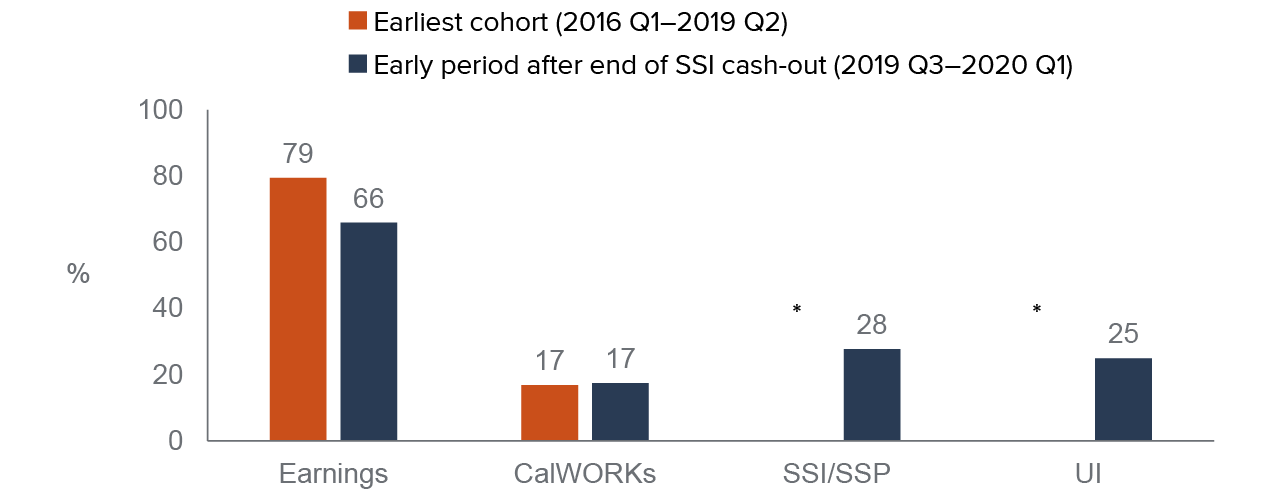
SOURCE: Author calculations from CDSS and EDD administrative data.
NOTES: Chart shows share of adults in cohort with income from source. * For SSI/SSP, excluded due to policy change starting in June 2019; for UI, data unavailable prior to July 2019. We track the earlier cohort for 6 quarters prior to CalFresh entry and 6 quarters after (including the entry quarter). The later cohort is tracked for 6 quarters prior and up to 6 quarters during/after (through the end of 2020). We do not present similar statistics for the pandemic cohort because our data ends in 2020—so we are unable to track them for the full twelve quarters. Calculations are based on recoded dollar values, as described in Technical Appendix C.
Incomes for these adults are notably low—in case-size adjusted terms averaging about $2,800 per quarter in the year prior to CalFresh start for the both cohorts, translating to about 88 percent of the federal poverty line. Earnings were notably higher prior to starting CalFresh for the cohort that started during the pandemic (about $4,400). CalFresh boosted incomes by nearly $500 on average in the quarter of entry for the pre-pandemic cohorts and over $600 for those who started during the pandemic (a 19% to 25% boost in the quarter of entry). Combined, earnings and safety net resources on average brought pre-pandemic participants to 98 percent to 107 percent of the poverty line in the year after CalFresh entry.
Incomes Are Unstable Before CalFresh Enrollment
Over the six quarters prior to CalFresh enrollment, adults commonly see large changes of at least 25 percent of their average income. Figure 2 shows that only about a third of adults (36%) experienced no large, quarter-to-quarter changes. About as many experienced temporary shocks to their incomes—both large, positive and large, negative changes (37%). Smaller shares experienced only a negative change or changes (14%), and the remaining 12 percent saw only a positive change or changes.
Large income swings are common before starting CalFresh
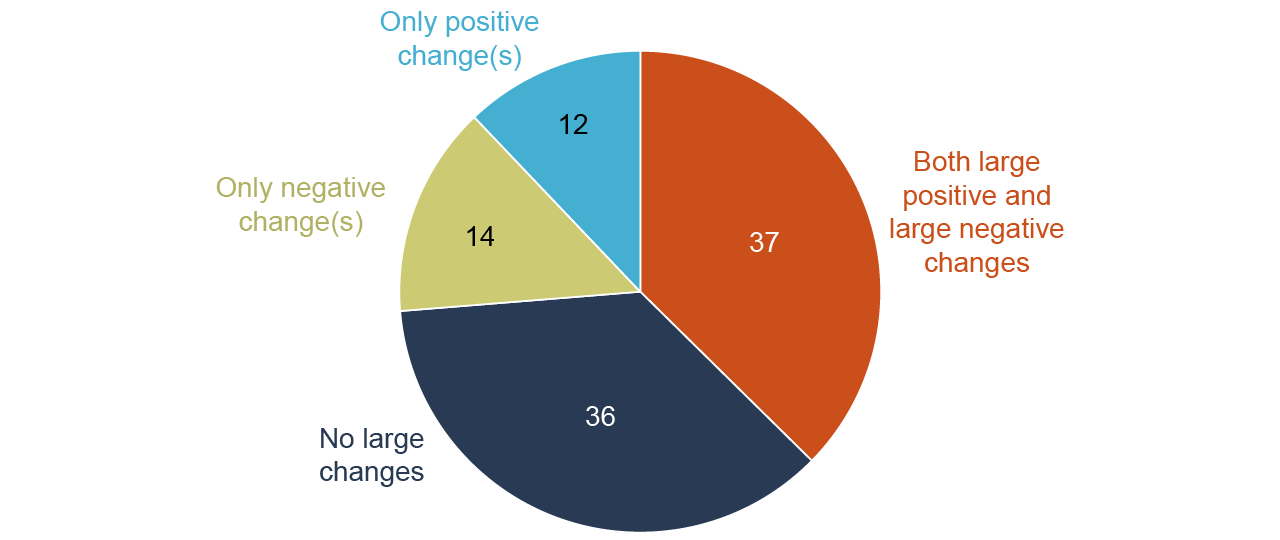
SOURCE: Author calculations from CDSS and EDD administrative data.
NOTES: Includes CalFresh entrants between January 2016 and June 2019. Changes are “large” if they are greater than 25 percent of an adult’s average income over twelve quarters.
Periods with No Earnings or Income Are also Common
Although most working-age adults hold at least one job around the time they access CalFresh, periods with no income from earnings are also relatively common (Thorman and Danielson 2022). For the early cohort—which was affected by the pandemic at least six months after enrolling in CalFresh—50 percent to 54 percent had earnings or a household member with earnings in any given quarter before or after their CalFresh start (Figure 3). This is about a third lower than the share ever having earnings over three years (Figure 1 above).
The group of adults who started CalFresh between April and September 2020 looks different: their employment levels were 10 to 12 percentage points higher before CalFresh start and then dropped to the levels of the earlier cohort (Technical Appendix Table D4). This group both experienced a very strong labor market before starting CalFresh and is probably compositionally different from earlier entrants; many of these adults likely would not have accessed CalFresh if not for disruptions caused by the pandemic.
For the early cohort, we also see 4 percent of adults with CalWORKs in the year before CalFresh start, rising to 12 percent in the quarter of entry. This may seem surprising because CalWORKs and CalFresh applications are typically in lockstep—and by definition these adults are not accessing CalFresh in the 12 months before entry. However, we are tracking household, not solely own, sources of income, and the small share with CalWORKs is most likely due to the focal adult’s temporary ineligibility for CalWORKs.
In the quarter they start CalFresh, CalWORKs income averages 21 percent of total income for the group of adults who ever have income from CalWORKs (Technical Appendix Table D5). Among this group, earnings make up 55 percent of income, while CalFresh makes up 23 percent.
The small share of the earliest cohort (4%) showing no CalFresh benefit in the quarter of CalFresh enrollment reflects both some amount of mismatch across data sources and our recoding procedures. It may also reflect the experiences of a very few adults who experience lengthy delays in receiving benefits. See Technical Appendix C for further details. Notwithstanding these small data anomalies, CalFresh becomes the most common income source in the quarter of CalFresh start across all three cohorts.
However, CalFresh receipt drops off dramatically between the first and second quarter after the quarter in which CalFresh starts (91% to 59%). This is driven by the requirement that CalFresh households submit a two-page Semi-Annual Report form (SAR-7) to demonstrate continued CalFresh eligibility. The substantial drop we document is in line with other research documenting excess rates of exit when semi-annual reporting comes due (Unrath 2021). By the fourth quarter after a new start on CalFresh, the share with income from CalFresh is lower than the share with income from earnings (47% vs. 53%).
Household income sources vary for adults accessing CalFresh
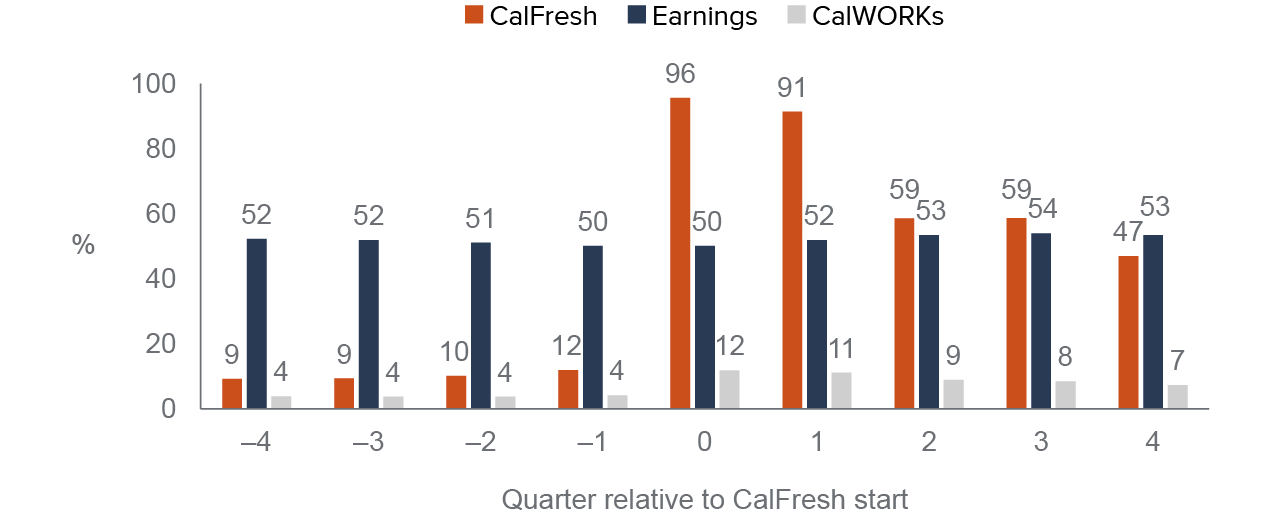
SOURCE: Author calculations from CDSS and EDD administrative data.
NOTES: We track income sources for six quarters before and after CalFresh entry; the figure shows nine of those twelve quarters. Household income sources tracked. Included is a cohort who began a spell of CalFresh between January 2016 and June 2019. Quarter 0 includes the entry month + the two subsequent months. As described in the text, SSI/SSP and UI income sources are excluded for policy and data reasons. Calculations are based on recoded dollar values, as described in Technical Appendix C.
Among these adults, experiencing one or more quarters with no household income from any tracked sources is common (Figure 4), with up to half of adults having no recorded income source in the year before CalFresh entry (36%–48% looking across all three cohorts). This parallels the share with no earnings shown in Figure 3.
However, income and earnings paths diverge once adults access safety net resources. Essentially all adults have some income in the quarter they enroll in CalFresh—here is it worth recalling that we conceptualize income as including CalFresh benefits. Even a year after starting CalFresh, about 80 percent have some income, whether from CalFresh, earnings, or other sources—a share that is markedly higher than the roughly half who had any income in the year before CalFresh start. Even given the income instability at the semi-annual reporting point that we have noted (and explore further below), this finding suggests a link between CalFresh participation and improved connections to the labor force and/or safety net programs. It is not clear whether CalFresh is solely stepping in to boost incomes in the short run, or also acting as a stepping stone to a more stable future; this is an important area for future research.
Safety Net Resources Boost Average Incomes
Comparing the evolution of adults’ incomes over several years helps us understand their trajectories (Figure 5). To capture short-run earnings and income volatility, we compute the mean of adults’ own income across 12 quarters. Because we include CalFresh as an income source and because all of these adults by definition have at least one month of CalFresh benefits, this mean is greater than zero. We then compare adults’ quarterly income to their mean income, computing the ratio to, and percent changes from, this mean. Ha et al. (2020) take a similar approach.
We see dramatic changes in participants’ resources over the period we track them. The overall trajectory indicates that income climbs substantially at the start of CalFresh relative to the adult’s several-year average and continues to rise in the following quarter to about 50 percent to 60 percent higher than the adult’s average. It does drop at the semi-annual reporting point, but continues to be higher the year after CalFresh enrollment (about 10%–40% higher than average) compared with the year before (about three-fifths to three-quarters of average). Overall, the bulk of income over the entire period comes from CalFresh and earnings.
After starting CalFresh, adults see large income gains
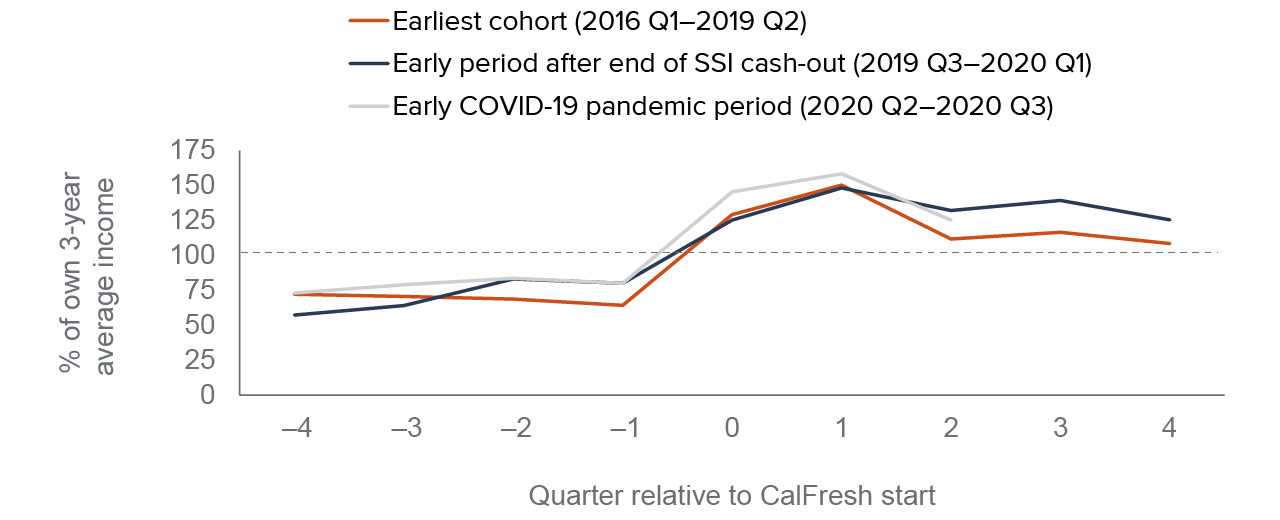
SOURCE: Author calculations from CDSS and EDD administrative data.
NOTES: Income refers to resources from earnings, CalFresh, CalWORKs, SSI/SSP, and/or UI. We track household income sources for a total of twelve quarters before and after CalFresh entry; the figure shows nine of those twelve quarters. Quarterly income and earnings are compared to period average income indicated by the horizontal line. Quarter 0 includes the entry month + the two subsequent months—also see the comparison of months and quarters shown in Technical Appendix Figure C1.
Adults see large and positive change at CalFresh entry, while the semi-annual reporting mark appears to be a chief point of negative change. Both changes imply that participants experience income instability at the point of CalFresh entry and exit, suggesting that adults are accessing CalFresh with a delay after their incomes have substantially dropped and leaving CalFresh before their incomes increase enough to end their eligibility.
This overall pattern is not markedly different over the three periods we consider, despite the changes in policy and economic conditions. However, there are key differences linked to recent employment experiences.
CalFresh Mitigates Earnings Losses for Participants with Recent Employment
About half of new entrants did not hold a job in the quarter before entry. The remainder either had reduced earnings from their primary employer or left their primary employer in the quarter before starting CalFresh. When we look at the recent employment experience of CalFresh entrants across the three cohorts, we can see that the share of new CalFresh participants who held no job in the quarter before enrollment was highest (65%) during the period when SSI/SSP participants become newly eligible for CalFresh, for reasons already discussed. The share without a job was lowest (46%) during the early months of the COVID-19 pandemic, with about one in five (21%) separating from a primary employer and nearly a third (32%) continuing in the same job with reduced pay (Table 1).
A majority of adults starting CalFresh are not employed in the quarter before entry
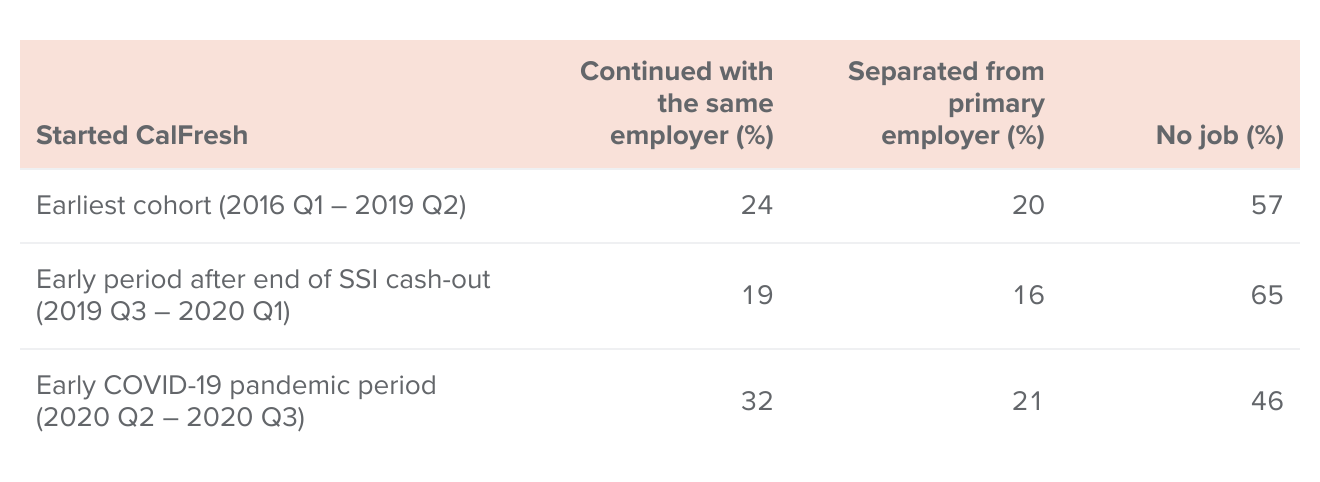
SOURCE: Author calculations from CDSS and EDD administrative data.
NOTE: See Technical Appendix C for a description of the employment categories shown.
CalFresh—and for some, an additional source of cash assistance—reduced earnings loss among those with current or recent employment. For the earliest cohort, average case-size-adjusted earnings for those continuing a job were about $4,900 in the quarter prior to CalFresh start; earnings dropped by 29 percent in the next quarter (Figure 6). While adults who separated from a job had similar earnings ($4,700) in the quarter before CalFresh enrollment, earnings loss is much starker (-98%) for this group. CalFresh reduced income loss to 52 percent. The pattern is similar for later cohorts. In other words, CalFresh does reduce instability for some. However, this group makes up less than half of those accessing CalFresh.
Typically, more than half of adults access CalFresh after a gap in employment. Among those with no job in the quarter before a CalFresh start, household earnings averaged only about $500. After enrollment, earnings increased by 55 percent, and income (earnings plus CalFresh and other safety net resources) increased to 137 percent of where it stood just before CalFresh. Given these adults’ very low levels of income at the point of CalFresh entry, these additional resources actually intensify instability by boosting incomes well above their own average.
CalFresh reduces earnings loss among adults with recent or ongoing employment
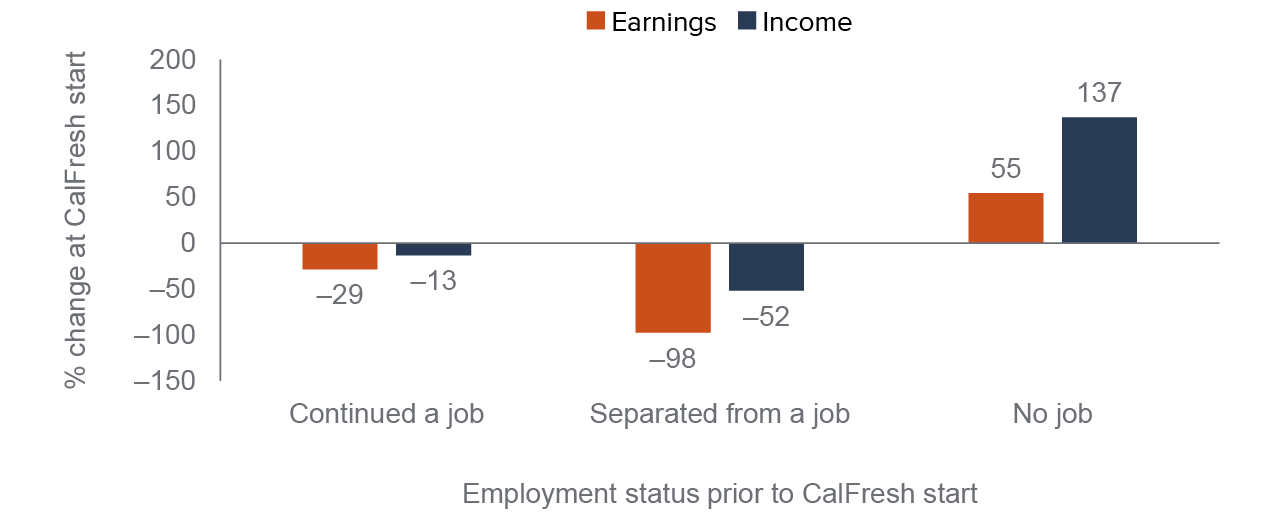
SOURCE: Author calculations from CDSS and EDD administrative data.
NOTES: Includes CalFresh entrants between Q1 2016 and Q2 2019. Changes shown are between first quarter before CalFresh entry and the quarter of entry; job status refers to the quarter prior to CalFresh entry. Quarterly change in income and earnings from the prior quarter to the indicated reference quarter compared with own average over 12 quarters. Earnings denotes UI-covered base wages and income is the combination of earnings, CalFresh benefits, and benefits from CalWORKs, and SSI/SSP.
Many Adults See a Large Income Drop Six Months after CalFresh Enrollment
When we look more closely at the point of semi-annual reporting, we see that adults with recent employment experience small quarter-to-quarter changes in both income and earnings (Figure 7). In contrast, those without a recent job see a moderate increase in earnings (6%), but a large drop in incomes (-66%). This indicates that CalFresh exit at the six-month mark is not driven by increased earnings. The CalFresh exits of so many with the lowest incomes is clearly a matter of concern, suggesting that the reporting burden is falling more heavily on those experiencing more disadvantage.
For those without a recent job, income changes are larger at the sixth month mark
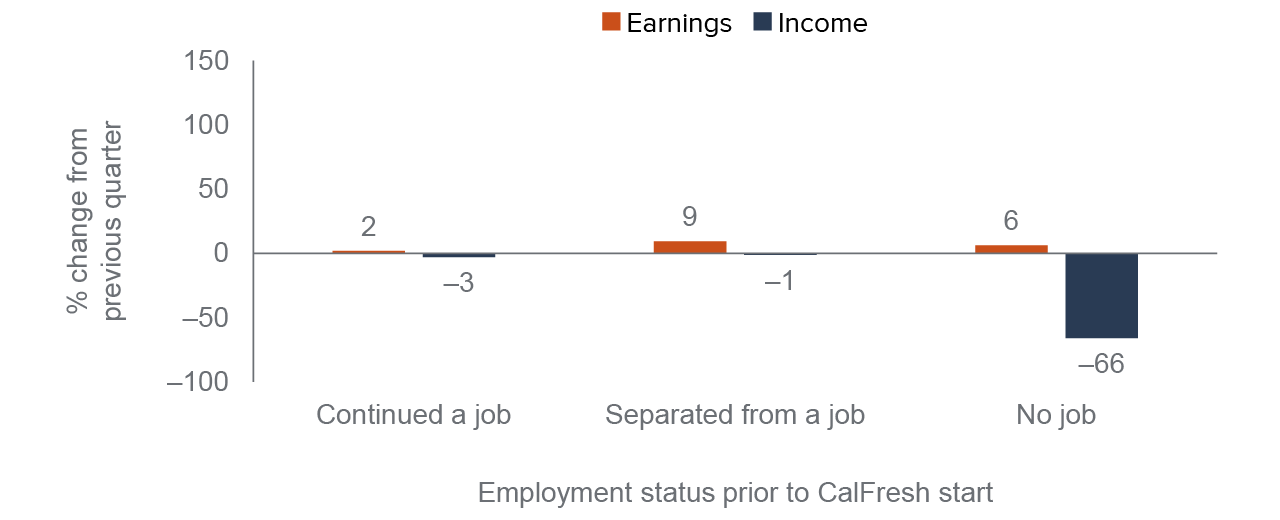
SOURCE: Author calculations from CDSS and EDD administrative data.
NOTES: Includes CalFresh entrants between Q1 2016 and Q2 2019. Changes shown are between first and second quarters after quarter of CalFresh entry (i.e., the 0th quarter); job history refers to the quarter prior to CalFresh entry. Quarterly change in income and earnings from the prior quarter to the indicated reference quarter compared with own average over 12 quarters. Earnings denotes UI-covered base wages and income is the combination of earnings, CalFresh benefits, and benefits from CalWORKs, and SSI/SSP.
In sum, we do find evidence that income instability decreases for some adults due to CalFresh and other safety net benefits. At the same time, the majority see a large increase in income at entry followed by a large decrease at the six-month mark. In part, this is due to individuals acquiring any recorded source of income—a sobering reality for these low-income adults—and indicates that CalFresh may be able to play a stabilizing role if these individuals can access the program closer to the point where they become eligible and maintain benefits for as long as they are eligible.
The Impact of Safety Net Resources Increased in the Early Months of the Pandemic
SNAP nutrition assistance is traditionally a vehicle for federal action to boost resources among low-income families during economic downturns, and the COVID-19 pandemic was no different (Technical Appendix A). Consistent with pandemic-prompted changes that increased benefits and reduced barriers to remaining on CalFresh, safety net resources increased incomes on average by a substantially larger amount for CalFresh entrants in the early months of the pandemic as compared with earlier cohorts (Figure 8). The percentage increase at CalFresh entry grew from 43 percent for those who started in the last quarter of 2019 to 67 percent among those who started CalFresh in the second quarter of 2020.
To some extent, this is unsurprising, since federal legislation temporarily increased SNAP benefit levels to the maximum for all participants in April 2020, with the result that the per person monthly CalFresh benefit grew from $134 in the last quarter of 2019 to $175 in the second quarter of 2020 (Food and Nutrition Service 2022).
It is also the case that those who accessed the program at the start of the pandemic had a much sharper decline in earnings as a group. Indeed, the average change in earnings was -4 percent among those who started CalFresh at the end of 2019, compared to -86 percent among those who started CalFresh in spring 2020.
Despite earnings declines, adults who started CalFresh at the beginning of the COVID-19 pandemic saw a larger boost to their incomes compared with those who started before
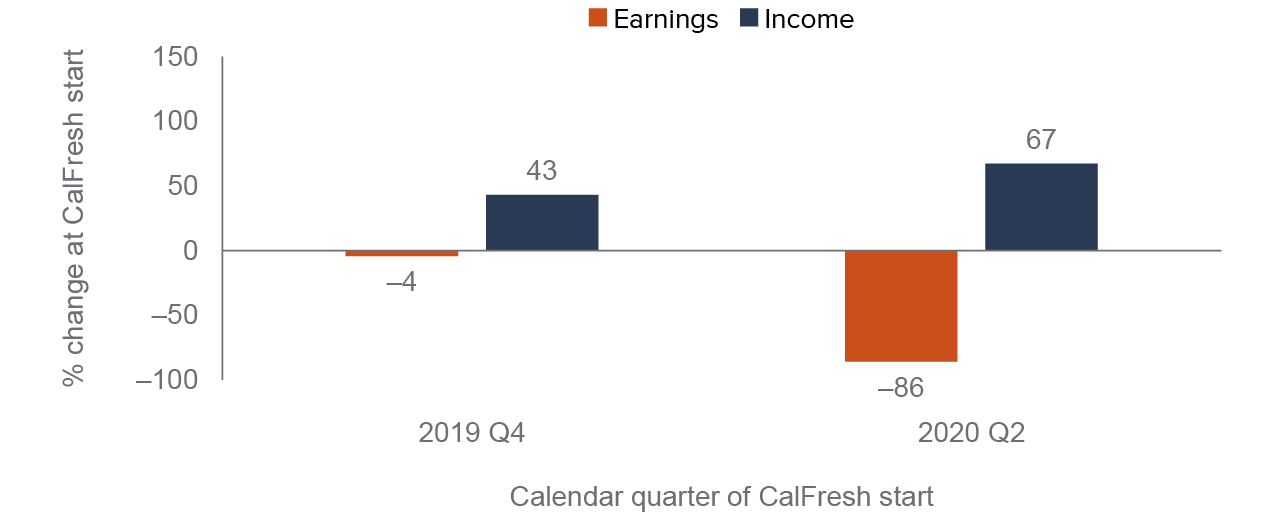
SOURCE: Author calculations from CDSS and EDD administrative data.
NOTES: Calendar dates indicate the year and quarter of CalFresh start. Changes shown are between first quarter before CalFresh entry and the quarter of entry. Quarterly change in income and earnings from the prior quarter to the indicated reference quarter compared with own average over 12 quarters. Earnings denotes UI-covered base wages and income is the combination of earnings, CalFresh benefits, and benefits from CalWORKs, SSI/SSP, and UI.
UI benefits unquestionably played a larger role over the early months of the pandemic—in line with temporary expansions to eligibility levels beginning in April 2020 (Figure 9). Only 5 percent of those who began a spell on CalFresh in the last three months of 2019 had income from UI by the first three months of 2020, while 18 percent of those who started CalFresh just prior to the pandemic had income from UI during the early pandemic months of April through June 2020. Among those who started CalFresh during the early months of the pandemic, more than a third had access to income from UI. Patterns of receipt were similar before the pandemic-induced UI expansions, suggesting a link between the sharp increase and temporarily expanded eligibility for UI.
As we have seen, those who turned to CalFresh in the early stages of the pandemic were also more likely to have had recent employment that could have qualified them for UI. UI also made up a sizeable share of household income early in the pandemic, ranging from 11 percent in the quarter of CalFresh start among adults with any history of CalWORKs receipt to 12 percent for those with no connection to another cash assistance program (Technical Appendix Table D5).
Adults who started CalFresh during the COVID-19 pandemic were more likely to have UI benefits
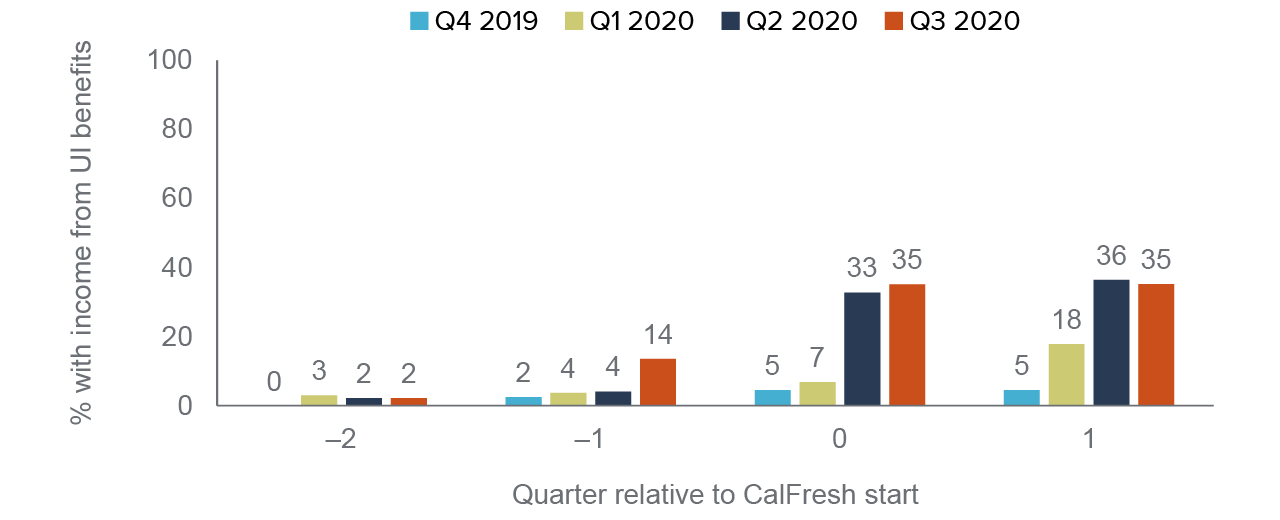
SOURCE: Author calculations from CDSS and EDD administrative data.
NOTE: Legend shows the year and quarter of CalFresh start. On the X-axis, “0” indicates quarter of enrollment in CalFresh.
How Much Do Family Demographics and Geography Matter?
We have noted that large income increases are common at the point of starting CalFresh—and that this is driven by a group of entrants who do not have a job the quarter before CalFresh start. Here, we look at whether there are systematic demographic or geographic differences in seeing a large jump in income. We also look at the same issue two quarters after starting CalFresh, when semi-annual reporting comes due. Relatedly, we consider whether there are systematic differences in a risk factor for experiencing a large income change: the occurrence of churning off and back on CalFresh within three months. Throughout, we focus on the early cohort in order to avoid confounding changes in CalFresh benefits at the start of the pandemic. It is possible that these relationships changed with the pandemic.
Controlling for calendar quarter of CalFresh start, age, and participation in safety net programs apart from CalFresh, we find essentially no regional differences in the overall probability (72%) of adults seeing a large change in income (Technical Appendix Table E3). Single adults—whose CalFresh case includes only themselves—are 17 to 26 percent more likely to see a large income change before CalFresh entry relative to cases with multiple adults and children. This difference for single adults is particularly the case for those continuing jobs at lower pay—suggesting that single adults with recent connections to the labor market see an outsized income drop in prior to starting CalFresh. Single parents—whose CalFresh case includes themselves and one or more children—also experience a higher probability of a large income change, but it is about half that of adults in single-person cases.
Participants whose race/ethnicity is reported as white, Black, or other/decline to state have a somewhat higher probability of large income increases at entry as compared with Latino participants. When we break down income changes by gender and the languages of written case materials, we find even smaller differences, which are typically not statistically significant.
We also see variation in the probability of having a large change in income at the point of semi-annual reporting (Technical Appendix Table E4), although regional differences are largely statistically insignificant. Overall, 52 percent of participants saw a large change at the second-quarter mark. White and Black participants and those recorded with other/decline to state race were 5 percent to 7 percent more likely than Latino participants to see large income changes.
Men and those with case materials not in English were also somewhat more likely to see a large change (3% and 8%, respectively). Single parents were 7 percent more likely than participants in households with children and more than one adult to see a large change. The largest difference is again for single adults, who have a 14 percent to 23 percent higher probability of experiencing an income jump two quarters after a CalFresh start.
If adults are leaving CalFresh while they are still eligible for benefits, we might expect to see groups with a higher risk of large income changes at the six-month point also experiencing one- to three-month gaps in CalFresh participation. About 13 percent of adults newly enrolled in CalFresh between 2016 and 2019 left and returned to CalFresh within a few months—commonly referred to as churning—at least once over the 16 months that we track them. Single adults—who are more likely to experience income jumps at the semi-annual reporting point—were a third more likely to experience to churn than cases with multiple adults and children (Technical Appendix Table E6). Latino participants were more likely to churn than Asian/Pacific Islander adults, although they were less likely to experience a large income change at the six-month mark. The opposite is true of those receiving case materials in a language other than English: they less often churned, but more often saw a large income change when semi-annual reports come due.
In sum, we do not find striking regional differences at the point of CalFresh entry or the point of semi-annual reporting. However, single adults consistently see substantially higher instability at these points, and they have a higher probability of churning.
Conclusion
CalFresh participants face the double challenge of low and unpredictable incomes. Most adults experience at least one large income swing before they enroll. For participants with recent employment, CalFresh stabilizes incomes; it appears to have played this role for many in the early months of the COVID-19 pandemic.
However, a large group of entrants starts CalFresh without recent employment and experiences income instability when benefits begin, albeit in the form of increased income. Since most adults have had employment within a year or two prior to CalFresh enrollment, it is reasonable to think that reaching these adults earlier could improve the stabilizing role of CalFresh—and also boost their incomes. Outreach to individuals who have not yet connected with the program is challenging; however, further strengthening links between UI and CalFresh could help.
We have also seen that participants without recent employment tend to see sharp income reductions at the semi-annual reporting point. As others have noted, there may be ways to automate income reporting to reduce the reporting burden (Unrath 2021). The pandemic pause in redeterminations could also be considered as a tool in the recessionary toolkit for the next economic downturn—in addition to bumping up benefits to help individuals and families meet basic needs.
Future research could provide a better understanding of delayed access to CalFresh among a large, particularly poor group. Additional research pinpointing the share and characteristics of low-income Californians who access CalFresh intermittently (as opposed to never accessing CalFresh) could help further refine strategies to increase the reach of the program.
Topics
COVID-19 Health & Safety Net Poverty & InequalityLearn More

California’s Nutrition Safety Net

Employment Patterns for CalFresh Adults

Federal Work Requirements Are Changing for Some CalFresh Participants

Policy Brief: Tracking CalFresh Participation among Young Children

Poverty in California

Video: The Importance of CalFresh in Unstable Times




